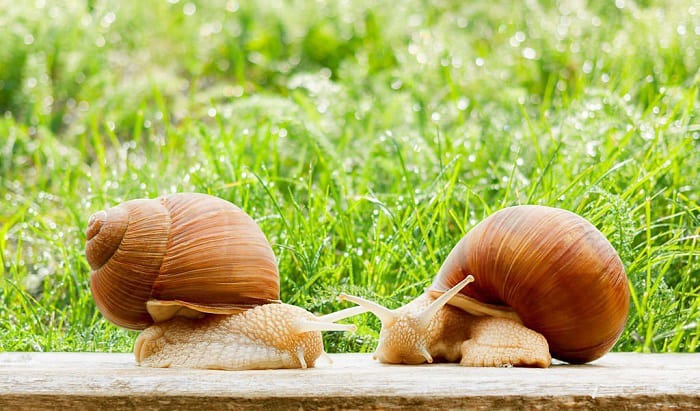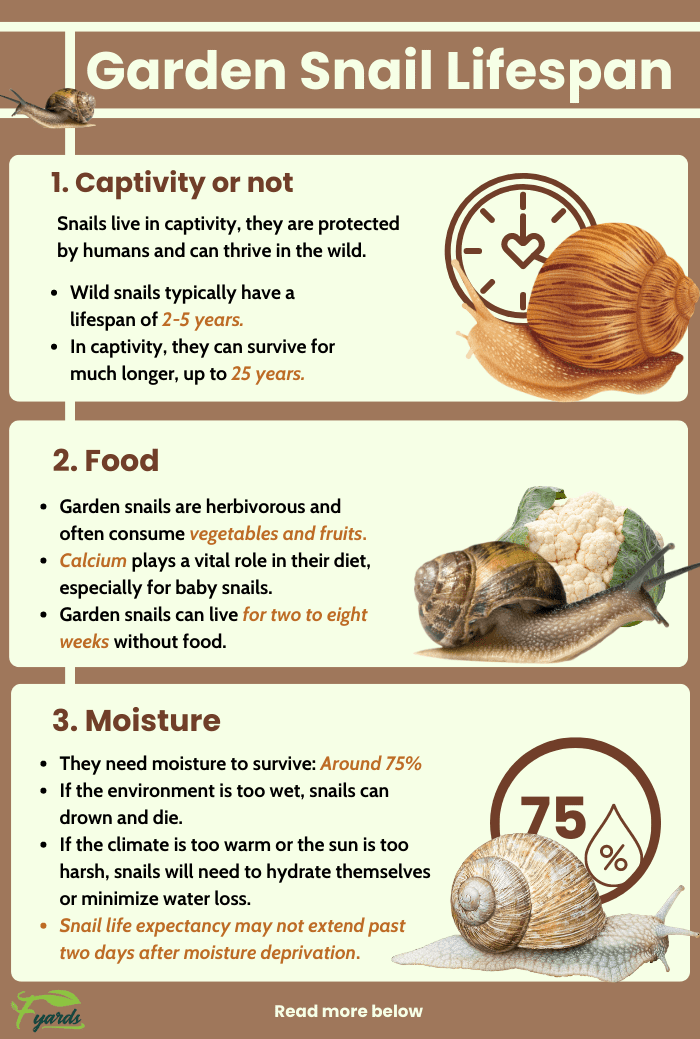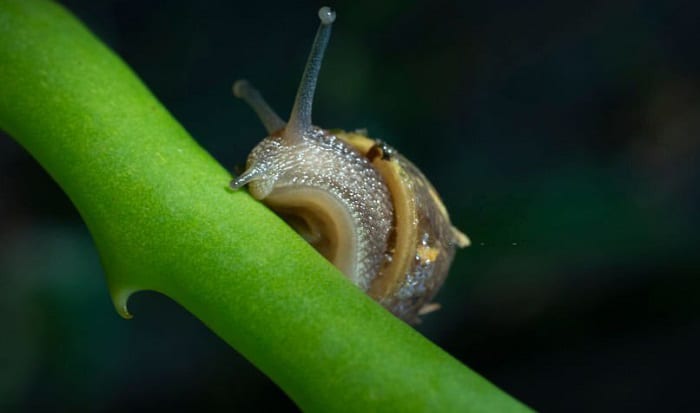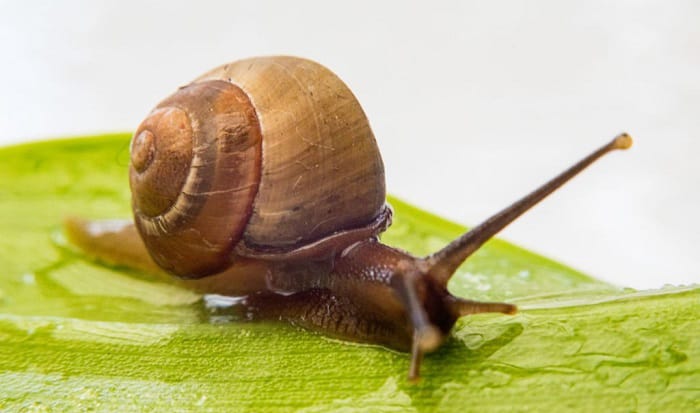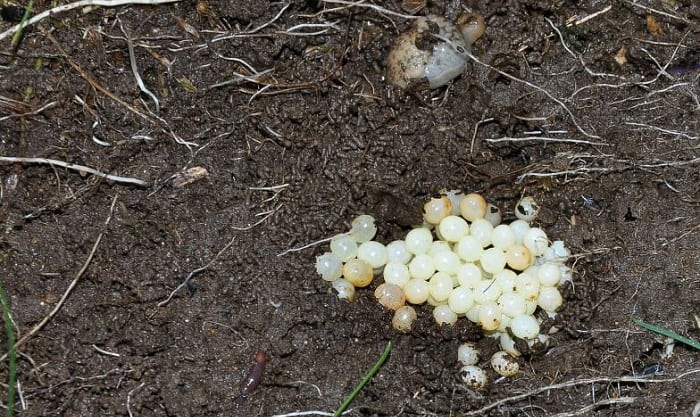Do you plan to keep snails as pets and wonder how they differ from cats or dogs? Or maybe, you’re just curious about these garden pests.
Whichever the case may be, how long do garden snails live is a common question. The average lifespan of snails is 10 to 15 years, but you can also find some that survive as long as 25 years.
Table of Contents
Garden Snail Lifespan
Some factors determine how long garden snails live. Learn about them below.
1. Captivity or not
Snails can live for a decade to fifteen years if left to themselves in nature. However, in captivity, they can survive for much longer, up to 25 years.
This is a generous estimate, however, as wild snails typically have a lifespan of two to five years.
Suffice to say, if garden snails are in the wild, they have to find food themselves and contend with predators and therefore are less likely to reach their maximum lifespan. On the other hand, when snails live in captivity, they are protected by humans and able to thrive.
2. Food
Like humans, snails need food to survive. Garden snails are herbivorous and often consume vegetables and fruits, which is why they are annoying pests many farmers try to get rid of.
Calcium plays a vital role in their diet, especially for baby snails. This substance allows these slimy creatures to form shells, maintain proper body functions, and control their muscles. Without calcium, the longevity of these mollusks decreases.
Garden snails can live for two to eight weeks without food; if they go longer without sustenance, they might deteriorate and die. The only exception to this rule is when they’re in aestivation or hibernation.
3. Moisture
Although garden snails don’t drink or breathe water, they need moisture to survive. A humidity level of around 75% is recommended, but if the environment is too wet, snails can drown and die. Interestingly, wind also affects a snail’s lifespan, as it can accelerate moisture loss.
If the climate is too warm or the sun is too harsh, snails will need to hydrate themselves or minimize water loss. They do this by finding vegetation to hide under and absorbing moisture from puddles and leaves.
If you plan to leave your house for several days at once, make sure to keep the snail container humid before your departure. Even then, remember that snail life expectancy may not extend past two days after moisture deprivation.
How Can You Tell How Old a Snail Is?
There are three ways to tell how old a snail is.
1. Rings on the shell
A snail gains one ring (or whorl) on its shell for every year of life. You just have to count the number of whorls it has.
2. Snail mouth
Land snails have an opening, which is called the mouth of the shell. In some cases, this area will be thicker or dotted with teeth if the snail is mature.
3. Body size
Usually, young land snails will be shorter than adult ones. “What length is tall for garden snails?” you may ask. In general, these snails can reach a length of 1.3 inches.
However, other species will have different size ranges. For example, giant African snails live up to 10 years and can grow as long as 8 inches, with the largest of this breed measured at 14.7 inches or 37.5 centimeters.
Apple snails, on the other hand, only reach about 6 inches in length; similarly, Mediterranean green snails are often 5 inches at maximum.
What Are Snails’ Main Threats?
There are different answers to this question, depending on how one understands it. You may be thinking of threats that endanger the life of snails, or the threat snails themselves have on plants and farming. Here, we’ll explore both of these lines of thought.
1. Snails as prey
In nature, snails have many predators, ranging from ducks, geese, to beetles, frogs, lizards, turtles, rats, weasels, and salamanders.
Notably, some snails even eat each other. For example, the Gray-foot Lancetooth will attack the Oval Ambersnail by piercing the latter’s shells.
Small mammals also prey on snails this way, while other species (such as the Cychrine beetles) may choose to enter the hole on the snail shell instead.
In response, snails have some measures to protect themselves.
First, they develop thicker shells and smaller apertures; this adaptation is observable in the Maze Pinecone and Stenotrema. Second, they form shell colors such as brown or tan to camouflage themselves and avoid detection.
Finally, snails can generate thicker and stickier mucus that confuses predators or looks toxic under UV rays.
2. Snails as threats to plants and farming
Snails eat many crops, with some mollusks consuming over 500 plant species. These slimy creatures will chew holes in leaves and even climb up trees to feed themselves, so your vegetables and flowers are not safe, no matter how distant they are from the ground.
Some of snails’ favorite plants are sweet peas, petunias, dandelions, asters, magnolias, thistles, yarrow, kale, spinach, peppers, and broccoli. It is best to look up whether snail foods are in your garden and have appropriate measures to protect your plants.
You can install copper tape around plant pots, for example, or use a beer trap.
The Life Cycle of a Snail
Snail eggs hatch after two weeks to one month of being laid, and young snails have soft shells that they need to build up with calcium. It is in this period of life that snails are the most vulnerable. Even though a pair of snails produce around 100 eggs, most of these eggs are destroyed by predators.
After hatching, snails take six weeks to five years before they can start mating. They secrete chemicals to attract partners and copulate to create offspring, even if the snails are hermaphrodites.
At this point, these mollusks are already adults and will continue to grow. Some may reach their highest life expectancy, while others will die prematurely.
Conclusion
How long do garden snails live? We hope you now have the answer. The lifespan of snails differs depending on their environment and food sources, and people can guess the age of these mollusks by examining their size, mouth, and rings.
If you like this article, please share it with others. Thank you for reading!

Hi, I am William – Floridayards’ digital content creator. My job is to find answers to all your concerns with thorough research and our team’s expert advice. I will also bring you honest reviews on the best products and equipment for raising your beautiful garden. Please look forward to our work!


